Learn how to make a latte at home that tastes just like a coffee shop! With espresso, steamed milk, and frothy foam, it’s simple and barista-quality.

Did you know you can make a barista-quality cafe latte in the comfort of your own home? After countless recipe tests, I’ve discovered the secrets to making lattes that rival anything from Starbucks or your favorite local coffee shop!
A latte is simply espresso combined with steamed milk and a thin layer of milk foam on top. The nice thing about making this espresso drink at home is that you can control every element to make a smooth, creamy latte at the fraction of a price of your average coffee shop drink.
Why You’ll Love This Latte
A classic latte ratio is one-third espresso to two-thirds milk, which makes a smooth, creamy coffee drink that’s slightly less intense than a cappuccino.
What makes it special is the silky microfoam, a layer of foam made by steaming the milk until it has a “wet-paint” like texture. It can be tricky to get to that texture without a steamer, but I’ll show you how to do it with various tools. Here’s why you’ll love this latte:
- Barista-quality results: I’ll show you how to make a latte whether you have an espresso machine or just have basic kitchen tools.
- Flexibility: You don’t need a fancy coffee maker (though that does help!). I’ll show you how to make strong coffee that mimics espresso using a French press or Moka pot.
- Budget-friendly: A Starbucks latte costs about $5, which can add up! The ingredients cost a fraction of the price: and you get the satisfaction of knowing you made it yourself.

Key Ingredients
Here’s what you need for making lattes at home:
- Espresso or strong coffee (2 shots/2 ounces): Use freshly brewed espresso from an espresso machine, or make strong coffee using my alternative methods. Dark roast beans work best for that authentic coffee shop espresso flavor.
- Fresh milk (4-6 ounces): Whole milk creates the richest, creamiest texture due to its fat content. It froths well and produces stable milk foam that holds its shape. 2% milk also works, making less stable foam. Milk that’s getting closer to its expiration date does not foam as well, so make sure it’s as fresh as possible.
- Optional sweeteners: Traditional lattes are unsweetened, but you can add sugar, honey, or flavored syrups to taste. Add the sweetener to the hot milk before frothing.
For milk alternatives, oat milk is my top recommendation. It steams similarly to dairy milk and makes a decent foam. Almond milk and soy milk also work, but they produce less stable foam. If you can find barista-style plant milks, they contain stabilizers that can help make the foam.
Step-By-Step: How to Make a Latte at Home
Once you’ve got your espresso and your tools, you can get to the good stuff! Here’s how to make a latte at home (or go to the recipe):
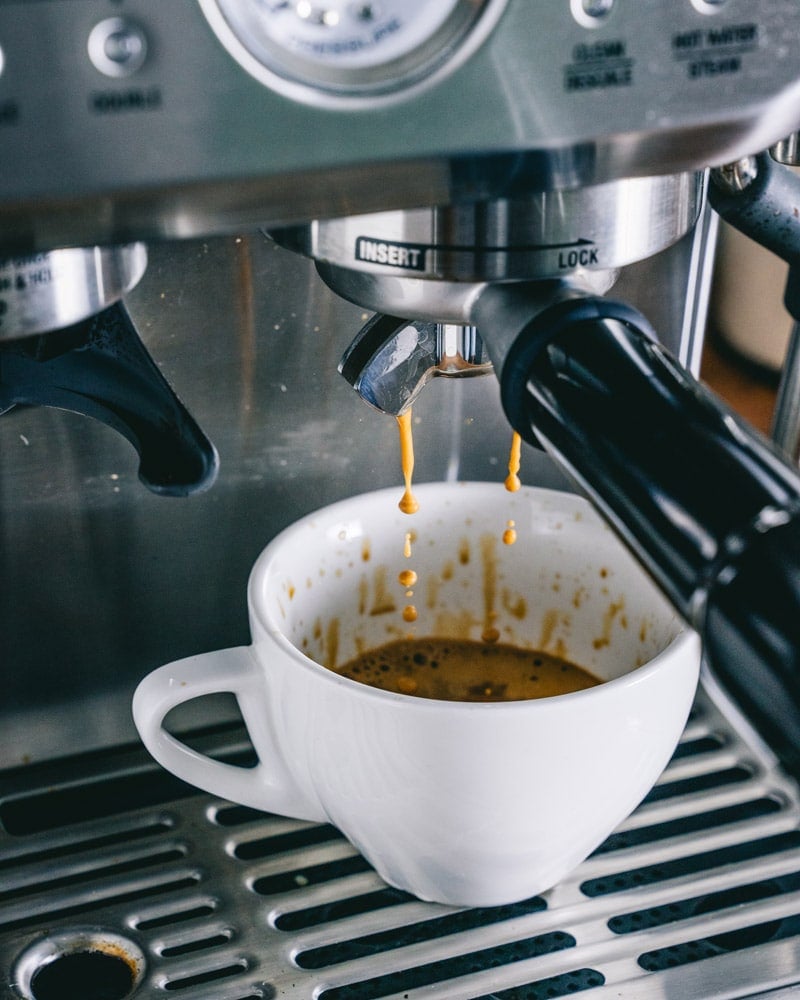
Step 1: Brew the espresso.
Make 2 shots of espresso or prepare strong coffee using one of these methods:
- Espresso machine: Use a countertop espresso machine, or the budget option, this manual espresso maker. (See my tutorial on How to Make Espresso.)
- Moka pot (Bialetti): Fill with water and coffee, heat on stovetop until it bubbles up. See Moka Pot Coffee.
- French press: Use double the normal coffee grounds, steep for 4 minutes. See French Press Coffee.
- Technically you can make Aeropress espresso or use a Nespresso machine, but the flavor is not nearly as good.
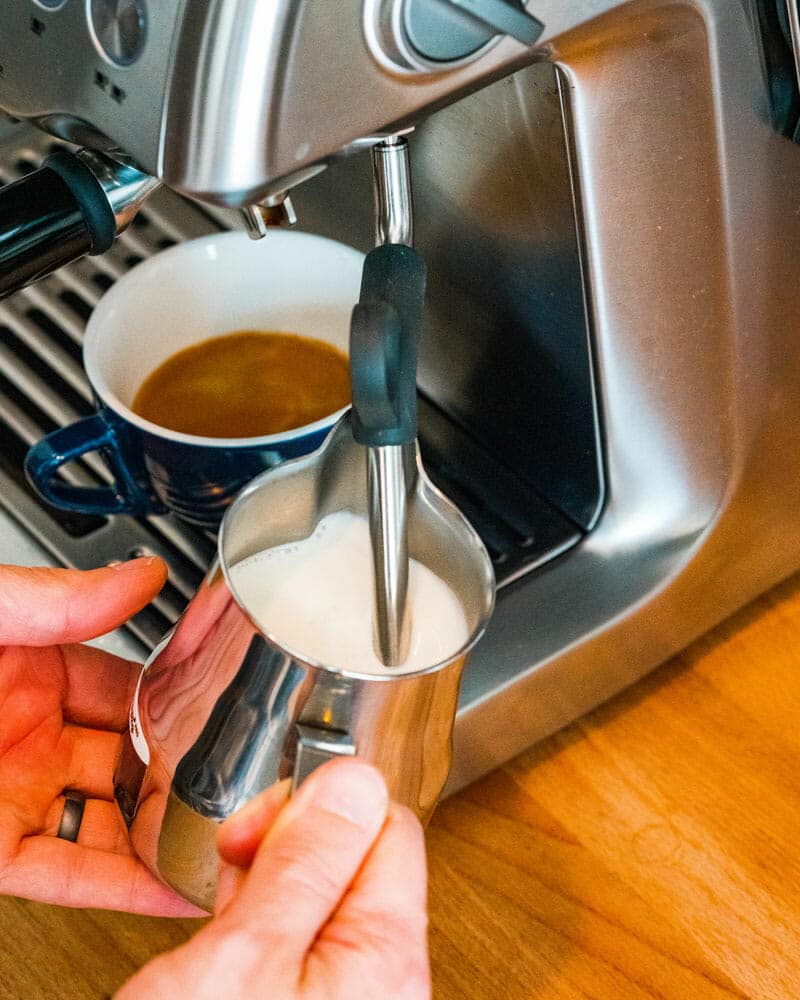
Step 2: Heat the milk and create the foam.
Warm 4-6 ounces of milk to 150-160°F. If using a stovetop, heat gently while stirring: don’t let it boil.
Then steam or froth your milk using your preferred method (detailed techniques below). You want small, uniform bubbles that create a paint-like consistency.
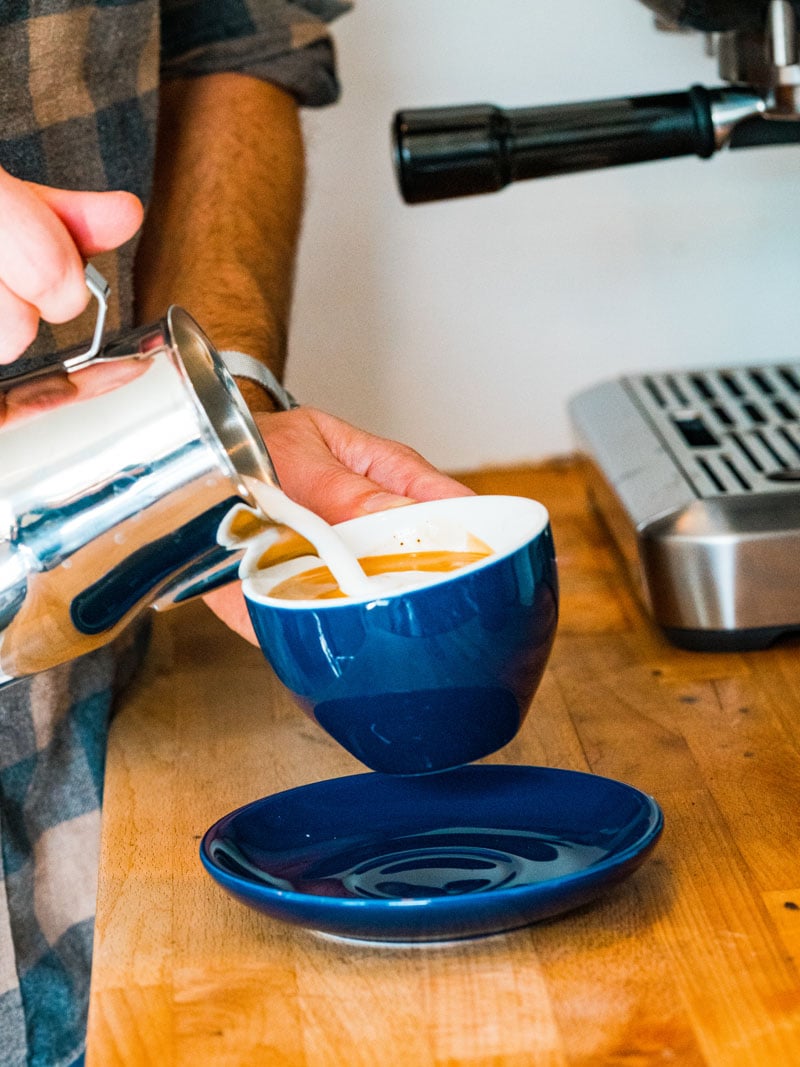
Step 3: Pour the milk into the espresso.
Start pouring from 3-4 inches high to help mix the coffee and milk. As the cup fills, bring the pitcher closer and slow your pour to float the foam on top.

Step 4: Add finishing touches and enjoy.
Dust with cocoa powder, cinnamon, or attempt some basic latte art if you’re feeling adventurous (see below).
Tips for Frothing or Steaming Milk
Steaming (using an espresso machine’s steam wand) creates microfoam: tiny bubbles that give the milk a velvety, paint-like consistency perfect for latte art. Frothing (using alternative methods) produces larger bubbles and a lighter, airier foam.
Steaming (With an Espresso Machine)
Espresso machines make the best microfoam, but they can be pricey. Here’s the espresso machine I use: it’s expensive but makes incredible quality coffee and I use it daily! Here’s how to steam milk for a latte using an espresso machine with steam wand:
- Pour cold fresh milk (less than 1 week old) into a stainless steel pitcher, filling it one-third full.
- Purge the steam wand by releasing steam for 2 seconds. Place the wand tip just below the milk’s surface at an angle.
- Turn on the steam. Hold the steaming wand just below the surface of the milk until it doubles in size (it should take a few seconds).
- Move the wand lower near the side of the pitcher to create a spiral vortex. This makes the smooth microfoam and wet-paint texture that’s characteristic of a latte. Steam until the milk reaches 150°F. Use a thermometer or judge by when your hand can’t hold the pitcher for more than a few seconds.
- Tap the pitcher on the counter and swirl to eliminate large bubbles.
Go to my tutorial on How to Steam Milk for more details!
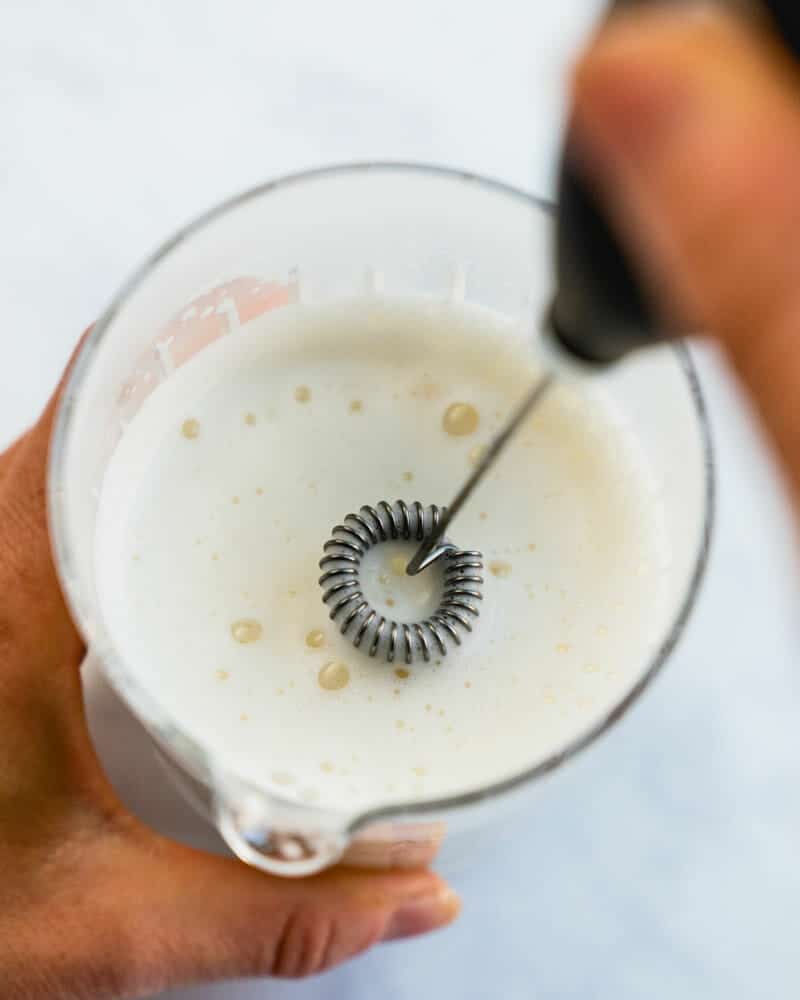
Frothing (Without a Machine)
You don’t need an espresso maker with steamer to make a great latte at home! You can simply heat and froth the milk, which tastes nearly as good. There are a few different handheld tools you can use to froth milk for a latte.
To learn how to froth, go to my tutorial How to Froth Milk or head to the recipe below. Here are a few great tools for the home barista for frothing milk:
- Handheld milk frother (top choice): A handheld milk frother is inexpensive and works well. It gets the milk extremely frothy, so it’s easy to make a macchiato or cappuccino. It’s a little trickier to make a great latte with a frother, but you can follow the tips below to get a great drink.
- French press (a close second): If you have a French press, it’s also great for making foam! It makes a nice frothy foam with bubbles a little larger than the frother.
- Whisk (use in a pinch): A whisk can works, but it makes a looser foam with larger bubbles. This method generates less foam than the frother or French press.
Ratios and Serving Sizes
The classic latte ratio is between 1:2 to 1:3 (one part espresso to two or three parts milk), but this varies with serving size:
- 6-ounce latte (traditional size): 2 ounces espresso (double shot), 4 ounces steamed milk
- 12-ounce latte (tall): 2 ounces espresso (double shot), 9-10 ounces steamed milk
- 16-ounce latte (grande): 3 ounces espresso (triple shot), 12-13 ounces steamed milk
Tip: A latte cup is nice for making lattes at home, because it is designed to hold exactly the right volume of espresso and foam! Here’s the 6 ounce latte cup that I use. (It also can be used for treats like mug cakes!).
For comparison, cappuccino uses equal parts espresso, steamed milk, and foam (1:1:1), and a a flat white uses a 1:2 ratio with a very thin layer of foam.

Latte Art Basics
Once you’ve mastered making a homemade latte, latte art becomes a fun challenge. My husband Alex spent months practicing before mastering his first heart design. It requires a lot of practice!
The foundation of latte art is microfoam with the right consistency: the milk should move like wet paint when you swirl the pitcher. This is easiest to achieve using the steam wand of an espresso machine (it doesn’t work with a handheld frother).
Check out my complete Latte Art Tutorial for step-by-step instructions.
Flavor Ideas and Add-Ins
While I love a classic latte, these flavor variations keep things exciting:
- Vanilla Latte: Add ½ to 1 tablespoon of vanilla syrup to your milk before steaming. Get my Vanilla Latte recipe.
- Lavender Latte: Add 1 tablespoon lavender syrup. Get my Lavender Latte recipe.
- Pumpkin Spice Latte: Mix pumpkin and maple syrup into the espresso. See my Pumpkin Spice Latte Recipe.
- Dirty Chai Latte: This fusion of coffee and tea creates an incredibly complex flavor profile: try my Dirty Chai Latte recipe.
- Iced Latte: Pour espresso over ice, add cold milk (no frothing needed!), and sweeten to taste. Go to my Iced Latte recipe.
Frequently asked questions
A cappuccino has equal parts espresso, steamed milk and foam (⅓ each). A latte has ⅓ espresso and 2/3 steamed milk, with a thin layer of foam on top. Here’s a visual chart.
Read more in my article about the difference between a latte and a cappuccino.
While traditional lattes require espresso, you can make an approximation using very strong regular coffee. Brew dark roast coffee at double strength: use twice the normal amount of grounds. A French press or pour over method works best for this.
For true barista-quality lattes, an espresso machine with a steam wand is ideal. The Breville Barista Express offers excellent value, combining a grinder, espresso maker, and steam wand. For budget options, a Nespresso machine with an Aeroccino milk frother produces consistent results, or you can use a manual espresso maker. If you already have a coffee maker, simply add a good milk frother.
Start by perfecting your milk texture: latte art is impossible without properly steamed milk. Watch video tutorials to understand pouring techniques, then begin with simple patterns like hearts or dots. Use whole milk for best results. Most importantly, practice daily: my husband Alex made terrible latte art for three months before achieving anything that looked decent.
See my detailed latte art tutorial for step-by-step guidance.
Dietary notes
This latte recipe is vegetarian and gluten-free.
How to Make a Latte (Cafe Latte)
Here’s how to make a latte at home! This cafe latte has the best creamy body and frothy milk, and tastes better than a coffee shop.
- Prep Time: 10 minutes
- Cook Time: 0 minutes
- Total Time: 10 minutes
- Yield: 1 drink
- Category: Drink
- Method: Espresso
- Cuisine: Coffee
- Diet: Vegetarian
Ingredients
- 2 espresso shots (2 ounces)
- 4 ounces (½ cup) fresh whole milk*
Instructions
- Make the espresso: Use an espresso machine or manual espresso maker to make two shots of espresso and pour it into a mug (or try our Aeropress Espresso).
- Steaming method (espresso machine): Place the milk in a pitcher. Hold the steaming wand just below the surface of the milk until it doubles in size. This makes foamy froth. Then, move the steaming wand lower and near the side of the pitcher to create a spiral vortex. This makes the silky smooth microfoam bubbles and wet-paint texture that’s characteristic of a latte. Steam until the milk reaches 150 degrees Fahrenheit (use a thermometer or judge by when your hand can’t hold the pitcher for more than a few seconds).
- OR, heat the milk to scalding and foam it (without espresso machine): Heat the milk to 150 degrees Fahrenheit, which is hot to the touch but not simmering. Measure with a food thermometer, or you can approximate by testing with your finger. Use a milk frother, French press or whisk to froth milk into small, even bubbles. For a latte you’ll want small bubbles and lightly thickened milk (if you’re using a milk frother, don’t go too far: you want the milk to mix in with the coffee so you don’t need too much froth). For the French press method, note that it’s useful to have at least 1 cup to have more milk to work with: this makes enough for 2 drinks. We highly recommend reading How to Froth Milk if this is your first time frothing. Wait 30 seconds to 1 minute to get the foam to incorporate into the milk and separate slightly (exact timing depends on your foaming method).
- Serve: Tap the milk container on counter and swirl it to break down any large bubbles. Pour milk into center of the espresso, ending with light foam.
Notes
*Whole milk works best; milk that is a few weeks old may not froth. You can also use oat milk for a vegan latte. The milk frother works well; for the French press pump vigorously until frothy, about 25 times. Do not overwhip, as the foam will deflate!
More Coffee Recipes You’ll Love
from A Couple Cooks https://ift.tt/1sg5erD
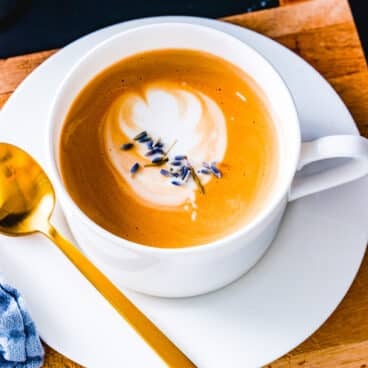







0 comments:
Post a Comment